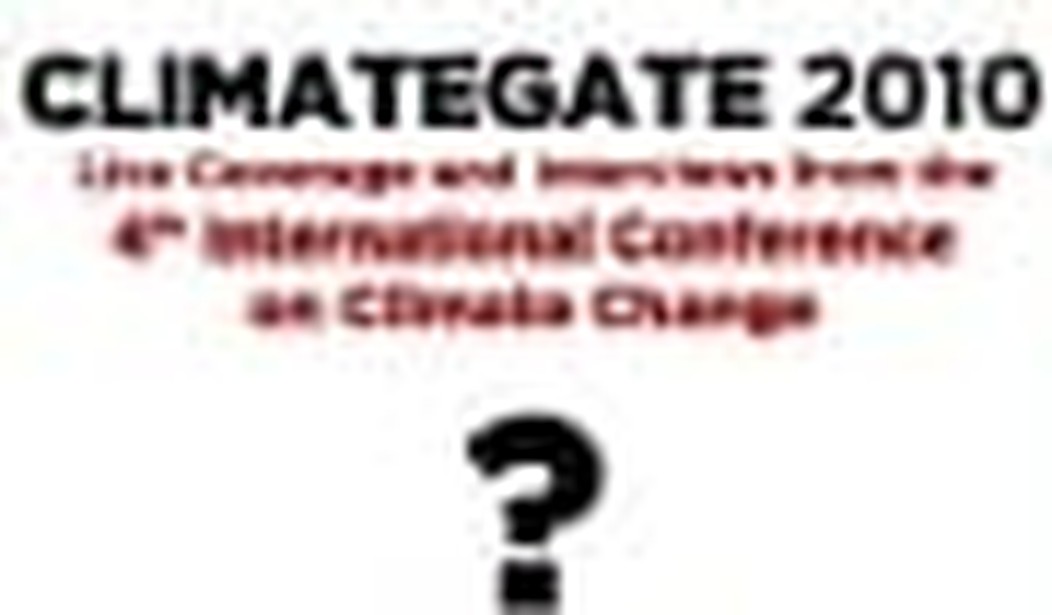In the wake of the Climategate scandal, panelists and audience members at the Fourth International Conference on Climate Change (ICCC4) indicated growing confidence that the tide is turning in favor of those who believe that manmade global warming is not a crisis.
More than 700 people — including a good many scientists, along with economists, policy analysts, and legislators — have gathered together since Sunday night, discussing the once-settled but increasingly controversial proposition of an anthroprogenic global warming (AGW) crisis. Any triumphalism was averted by a general agreement to explore real-world facts and test the assertions of alarmists. The presenters and audience members continually asked whether the data says what the modelers say it does.
The conference opened with a Sunday evening dinner at which Canadian statistical analyst Stephen McIntyre presented a meticulous history of the hugely influential “hockey stick” graph — which found an alarming rise of global temperatures since 1979 and led to the IPPC conclusion that AGW is causing a global crisis that requires drastic measures. McIntyre had begun publicly questioning the data several years ago, setting off an effort which ultimately led to the recent Climategate scandal, in which it was shown that the people behind the hockey stick graph knowingly altered the temperature record in a way that expanded a relatively common global temperature change into a shocking heat spike.
The scientists’ own words show them as phonying up temperature data “in order to trick you,” as McIntyre noted repeatedly in his presentation, quoting comedian Jon Stewart’s scathing mockery of the alarmists’ attempted evasions. McIntyre quoted extensively from the various parties that perpetrated this massive fraud, but he avoided using such emotionally charged words. Fellow keynote speaker Harrison Schmitt — a Ph.D. scientist and former NASA astronaut — by contrast, embraced the characterization of the Climategate events as a fraud, in response to audience comments in a lively Q&A session after McIntyre’s speech. The questioners strongly criticized McIntyre’s reticence and his argument supporting a central role for government in pressing a climate agenda.
The disagreement demonstrated that the increasing skepticism toward the AGW crisis hypothesis is not the result of an organized effort by energy industry shills but instead a serious movement investigating a scientific proposition carrying enormous political and economic implications. At breakfast on Monday, the eminent environmental sciences scholar Pat Michaels, Ph.D., a past president of the American Association of State Climatologists, employed much humor and telling details in documenting an extensive cover-up by alarmists in stopping publication of articles by AGW skeptics in Climate Science and other refereed science journals. Noting that a prominent alarmist called for the editor of Climate Science to be fired for not spiking AGW skeptics’ articles, Michaels observed: “This is a hanging offense in science.”
The real core of the conference has been the panel sessions, in which scientists, economists, and other experts present the facts about the environmental effects of human activity and the causes of global temperature changes. Given that four panels were meeting at any one time, attendees were forced to make some tough choices. But in each case, the emphasis was on presenting the facts, and in the three panels I attended I heard some strong words but no polemics.
In a morning science session, for example, Craig Idso, Ph.D., presented preliminary results from his upcoming massive meta-analysis of the scientific literature on ocean acidification — the largest such analysis ever, using results from 568 research studies. “Those who continue to portray CO2-induced ocean acidification as megadisaster-in-the-making are not grounded in the real world data,” he said — but only after presenting the data proving it. And in contrast to the Climategate events outlined in Sunday night’s keynote address by Stephen McIntyre, Idso is publishing all the data online.
The economics of AGW policies are becoming an increasingly important issue as draconian cap-and-trade bills make their way through Congress, and presenters offered sobering facts about emission trading schemes. Dr. David Tuerck of the Beacon Hill Institute gave his chilling estimate of the price tag of “ruinously costly,” unnecessary environmental initiatives such as Waxman-Markey ($3.42 trillion) and the Western Climate Initiative ($6-18 billion per year). On that same panel, Spanish economics professor Dr. Gabriel Calzada addressed the claims that green policies create large numbers of jobs. In Spain, he observed, “green jobs are created by green rain” — huge taxpayer subsidies: 570,000 euros per green job created. As a result of the tax-subsidized increase in the use of renewables, in 1998-2009 the price of electricity in Spain rose by 77 percent, he observed. Fellow panelist Dr. Carlo Stagnaro, an environmental engineer from Italy, noted that for every green job, 6.9 jobs could be created in the industrial sector for the same investment.
Tuerck bluntly suggested a rational approach to energy efficiency would start by eliminating all subsidies for energy production, across the board. He argued that such an approach could be a populist-style measure on which both free-market advocates and green groups can agree.
The luncheon keynote speech by atmospheric scientist Dr. Richard Lindzen of MIT explained how climate models draw disturbingly high estimates of future global temperature increases as a result of higher atmospheric CO2: they introduce arbitrary fudge factors (which they call “strong positive feedbacks”) that jack up the estimates far beyond the scientifically observed fact that a doubling of CO2 would cause only a 1 degree C temp increase. Overall, the warming observed over the past century is quite trivial, and natural variability explains it fully, he said; no additional, non-natural (human) forcing need be sought in order to understand the data. In fact, real-world observations show the feedback effect as negative. Hence the only way to raise alarm over global mean temperature is to claim future results will be much more extreme than what we’ve observed in the past. That is exactly what AGW alarmists do, Lindzen observed.
More facts: In a standing-room-only afternoon session, Joseph D’Aleo outlined discrepancies in temperature data from various official sources, documenting the frequent “adjustment” of raw temperature by the National Oceanic and Atmospheric Administration, which always happens to decrease past temps and increase recent ones. That’s what created the infamous “hockey stick” temperature graph which turned a small observed temperature increase into an alarming hypothesized one. “Manmade warming is real, but it’s made by men in East Anglia and at NOAA,” D’Aleo tartly observed.
Fellow panelist Dr. Fred Singer, the distinguished environmental sciences scholar and coauthor of “Climate Change Reconsidered: The 2009 Report of the Nongovernmental International Panel on Climate Change,” likewise presented “many reasons to doubt” the surface temperature data showing an unusual increase in global temperatures in the 1980s and ’90s. “My view of the post-1997 warming is that it may be phony,” he said.
While allowing much room for disagreement on the details, the attendees at ICCC4 seemed to agree on one thing: policies with such enormous consequences should be based on the facts, however inconvenient they might turn out to be.
S. T. Karnick is director of research for The Heartland Institute (www.heartland.org) and editor of The American Culture (http://culture.stkarnick.com).
(DON’T MISS PJTV: LIVESTREAMING THE CHICAGO CLIMATE CONFERENCE.)









Join the conversation as a VIP Member